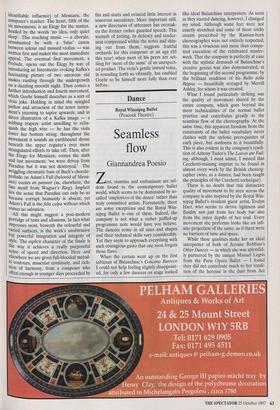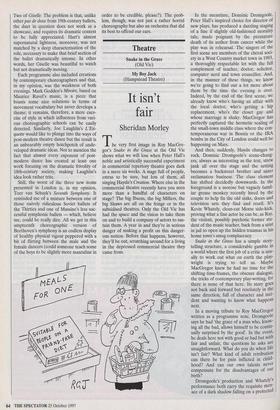Dance
Seamless flow
Giannandrea Poesio
Zest, stamina and enthusiasm are sel- dom found in the contemporary ballet world, which seems to be dominated by so- called 'employees of the dance' rather than truly committed artists. Fortunately, there are some exceptions and the Royal Win- nipeg Ballet is one of them. Indeed, the company is not what a rather puffed-up programme note would have you believe. The dancers come in all sizes and shapes and their technical skills vary considerably. Yet they seem to approach everything with such contagious gusto that one soon forgets those flaws.
When the curtain went up on the first tableaux of Balanchine's Concerto Barocco I could not help feeling slightly disappoint- ed, for only a few dancers on stage looked like ideal Balanchine interpreters. As soon as they started dancing, however, I changed my mind. Although some feet were not exactly stretched and some of those tricky counts prescribed by the Russian-born choreographer were not entirely respected, this was a vivacious and more than compe- tent execution of the celebrated master- work. That the company is perfectly at ease with the stylistic demands of Balanchine's creative genius was also demonstrated, at the beginning of the second programme, by the brilliant rendition of his Ballo della Regina — beautifully restaged by Merrill Ashley, for whom it was created.
What I found particularly striking was the quality of movement shared by the entire company, which goes beyond the mere technicalities of the normal ballet practice and contributes greatly to the seamless flow of the choreography. At the same time, this apparent freedom from the constraints of the ballet vocabulary never clashes with the stylistic prerequisites of each piece, but conforms to it beautifully. This is also evident in the company's rendi- tion of Antony Tudor's The Leaves are Fad- ing, although, I must admit, I missed that Cecchetti-training imprint to be found in almost every work by the British choreog- rapher (who, as a dancer, had been taught the principles of the Cecchetti technique).
There is no doubt that this distinctive quality of movement to be seen across the company is also inspired by the Royal Win- nipeg Ballet's resident guest artist, Evelyn Hart, who seems to derive lightness and fluidity not just from her body but also from the inner depths of her soul. Every movement she performs looks like an infi- nite projection of the same, as if there were no barriers of time and space.
While these qualities make her an ideal interpreter of both of Jerome Robbins's Other Dances — in which she was splendid- ly partnered by the unique Manuel Legris from the Paris Opera Ballet — I found they did not contribute much to her rendi- tion of the heroine in the duet from Act Two of Giselle. The problem is that, unlike other pas de deux from 19th-century ballets, the duet in question does not work as a showcase, and requires its dramatic context to be fully appreciated. Hart's almost supernatural lightness, moreover, was not matched by a deep characterisation of the role, necessary to make that brief section of the ballet dramatically intense. In other words, her Giselle was beautiful to watch but not dramatically moving.
Each programme also included creations by contemporary choreographers and that, in my opinion, was the weakness of both evenings. Mark Godden's Miroirs, based on Maurice Ravel's music, is a piece that boasts some nice solutions in terms of movement vocabulary but never develops a theme; it remains, therefore, a mere exer- cise of style in which influences from vari- ous choreographic schools can be easily detected. Similarly, Joe Laughlin's L'Eti- queue would like to plunge into the ways of post-modern theatre dance but the result is an unbearably empty hotchpotch of unde- veloped dramatic ideas. Not to mention the fact that almost every exponent of post- modern dance has created at least one work focusing on the dramatic frivolity of 18th-century society, making Laughlin's idea look rather trite.
Still, the worst of the three new items presented in London is, in my opinion, Toer van Schayk's Seventh Symphony. It reminded me of a mixture between one of those naively ridiculous Soviet ballets of the Thirties and one of Massine's less suc- cessful symphonic ballets — which, believe me, could be really dire. All we get in this umpteenth choreographic version of Beethoven's symphony is an endless display of healthy physical vigour peppered with a bit of flirting between the male and the female dancers (could someone teach some of the boys to be slightly more masculine in order to be credible, please?). The prob- lem, though, was not just a rather horrid choreography but also an orchestra that did its best to offend our ears.



















































































 Previous page
Previous page